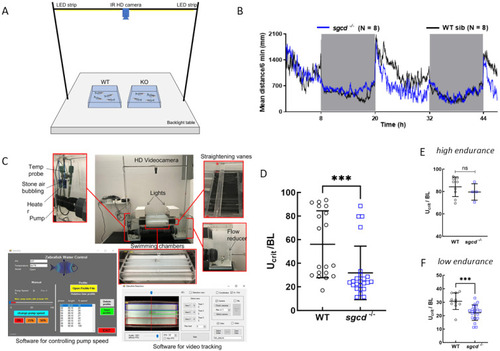
Swimming performance of the adult wild type and sgcd−/− zebrafish. (A) Tracking system and representative arena of 40 × 40 cm for adult zebrafish. (B) Distance moved by 7-month-old sgcd−/− and wild type siblings. After a few hours of habituation, the fish movements were recorded for 48 h under a 12:12 LD cycle. Each point represents the mean value of the distance moved in 6 min by eight wild type (black trace) and eight mutated animals (blue trace). With this set-up, it is not possible to record the movement of a single fish. (C) The in-house developed swimming tunnel system that was conceived to allow for the simultaneous testing of three adult zebrafish in the swimming chambers (Lucon-Xiccato et al., 2021 [37]). (D) Swimming performance of adult fish (1-year-old), 19 wild type and 24 sgcd−/−. Fish were introduced in the swimming chambers and allowed to habituate for 60 min. Then, a counter current speed of 81.6 (cm/s) was applied. Fatigue was evaluated by measuring the time at which the fish stopped swimming counter current and contacted the rear section of the tunnel for >5 s (Ucrit). This value was normalized by the length of the fish. It is possible to see that the sgcd−/− fish were less resistant than the wild type ones. Two subpopulations, high endurance (E) and low endurance (F) fish, were distinguishable in both genotypes. Statistical analysis was performed by the Mann–Whitney test; ns, p > 0.05; ***, p ≤ 0.001.
|

